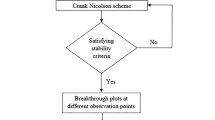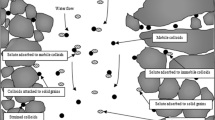Abstract
The presence of colloids and bacteria in groundwater affects contaminant migration either by facilitation or retardation. The co-transport of contaminant and colloidal particles had been simulated using various finite difference schemes which may suffer from the known and common numerical dispersion problem. In this study, a random walk particle tracking (RWPT) scheme is developed to simulate the co-transport of contaminants, colloids, and bacteria in porous media. Processes modeled include colloidal deposition to and release from solid matrix, bacterial attachment to and detachment from solid matrix, and contaminant sorption onto and desorption from mobile and immobile colloidal particles and bacterial cells as well as solid matrix. Also, the biological processes between contaminant and bacterial cells including bacterial growth, decay, and contaminant utilization are simulated. The developed model is verified against MT3D-MS for reactive contaminant transport with solid matrix, and reaction processes have been verified with solution of a developed analytical solution of mass balance equations. The biological processes are incorporated into the developed RWPT model which is verified against TVD finite difference model developed by (El-Kordy 2008). The results show good performance of RWPT technique in simulating contaminant transport in the presence of colloids and bacteria. The effects of various physical and biological parameters on contaminant transport are investigated. The results show that at least 50,000 particles are required to simulate each constituent mass in case of consideration of biological processes in contaminant transport simulation. On the other hand, 10,000 particles are found to be sufficient to simulate each constituent mass for case of contaminant transport undergoing physical and chemical processes only. The results indicate that contaminant utilization increases by increasing the ratio of initial concentrations of bacterial cells and contaminant, the ratio of the half-saturation constant to initial contaminant concentration, and the ratio of the maximum growth rate to the yield coefficient. It is also found from the results that higher contaminant utilization occurs at early time and decreases as time progresses.















Similar content being viewed by others
References
Ahmed MI, Abd-Elmegeed MA, Hassan AE (2019) Modelling transport in fractured media using the fracture continuum approach. Arab J Geosci 12:172. https://doi.org/10.1007/s12517-019-4314-3
Bekhit HM, Hassan AE (2005a) Two-dimensional modeling of contaminant transport in porous media in the presence of colloids. Adv Water Resour 28:1320–1335. https://doi.org/10.1016/J.ADVWATRES.2005.04.009
Bekhit H.M., and Hassan A.E. (2005b). Stochastic modeling of colloid-contaminant transport in physically and geochemically heterogeneous porous media. Water Resources Research. 41. W02010, https://doi.org/10.1029/2004WR003262.
Bekhit HM, Hassan AE (2007) Subsurface contaminant transport in the presence of colloids: Effect of nonlinear and nonequilibrium interactions. Water Resour Res 43:W08409. https://doi.org/10.1029/2006WR005418
Bekhit HM, Hassan AE, Harris-Burr P, Papelis C (2006) Experimental and numerical investigations of effects of silica colloids on transport of strontium in saturated sand columns. Environ Sci Technol 40(17):5402–5408
Bekhit HM, El-Kordy MA, Hassan AE (2009) Contaminant transport in groundwater in the presence of colloids and bacteria: model development and verification. J Contam Hydrol 108:152–167. https://doi.org/10.1016/j.jconhyd.2009.07.003
Bellin A, Salandin P, Rinaldo A (1998) Simulation of dispersion in heterogeneous porous formations: statistics, first-order theories, convergence of computations. Water Resour Res 28(9):2211–2277. https://doi.org/10.1029/92WR00578
Clement TP, Peyton BM, Ginn TR, Skeen RS (1999) In: Lewins J., Becker M. (Eds.) Modeling bacterial transport and accumulation processes in saturated porous media: a review. Advances in Nuclear Science and Technology, vol. 26. Kluwer Academic/ Plenum Publishers, New York, pp. 59–78.
Clement TP, Johnson CD, Sun YW, Klecka GM, Bartlett C (2000) Natural attenuation of chlorinated ethene compounds: model development and field-scale application at the Dover site. Contam Hydrol 42(2–4):113–140
Corapcioglu MY, Haridas A (1984) Transport and fate of microorganisms in porous media: a theoretical investigation. J Hydrol 72:149–169
Corapcioglu MY, Kim S (1995) Modeling facilitated contaminant transport by mobile bacteria. Water Resour Res 31(11):2639–2647
Derakhshannia M, Dalvand S, Asakereh B, Ostad-Ali-Askari K (2020) Corrosion and deposition in Karoon River, Iran, based on hydrometric stations. International Journal of Hydrology Science and Technology (IJHST) Inderscience Publishers 10(4):334–345. https://doi.org/10.1504/IJHST.2020.108264
El-Kordy M.A. (2008) Contaminant transport in groundwater in the presence of colloids and bacteria. MSc. Thesis, Faculty of Engineering, Cairo University, Giza, Egypt.
Freeze R.A., and Cherry J.A. (1979). Groundwater. Prentice-Hall, Inc., Englewood Cliffs, NJ. 604.
Gerba CP, Walis C, Melnick JL (1975) Fate of wastewater bacteria and viruses in soil. J Irrig Drain Eng 101:157–174
Ginn TR, Wood BD, Nelson KE, Scheibe TD, Murphy E, Clement TP (2002) Processes in microbial transport in the natural subsurface. Adv Water Resour 25:1017–1042
Golian M., Katibeh H., Singh V., Rostami H., and Ostad-Ali-Askari K., (2020), Prediction of tunnelling impact on flow rates of adjacent extraction water wells. Q J Eng Geol Hydrogeol, 53(2):236. The Geological Society of London, UK. https://doi.org/10.1144/qjegh2019-055
Harvey R.W., Harms H. (2001). Transport of microorganisms in the terrestrial subsurface: in situ and laboratory methods. In: Hurst CJ, Crawford RL, Knudsen GR, McInerney MJ, Stetzenbach LD (Eds.) Manual of Environmental Microbiology, Second Edition., pp. 753–776.
Harvey RW, George LH, Smith RL, LeBlanc DR (1989) Transport of microspheres and indigenous bacteria through a sandy aquifer: results of natural- and forced-gradient tracer experiments. Environ Sci Technol 23(1):51–56
Hassan AE, Cushman JH, Delleur JW (1997) Monte Carlo studies of flow and transport in fractal conductivity fields: comparison with stochastic perturbation theory. Water Resour Res 33(11):2519–2534
He JZ, Ritalahti KM, Aiello MR, Loffler FE (2003) Complete detoxification of vinyl chloride by an anaerobic enrichment culture and identification of the reductively dechlorinating population as a Dehalococcoides species. Appl Environ Microbiol 69(2):996–1003
Jenkins MB, Lion LW (1993) Mobile bacteria and transport of polynuclear aromatic hydrocarbons in porous media. Appl Environ Microbiol 59(10):3306–3313
Khafagy MM, Abd-Elmegeed MA, Hassan AE (2020) Simulation of reactive transport in fractured geologic media using random-walk particle tracking method. Arab J Geosci 13:34. https://doi.org/10.1007/s12517-019-4952-5
Katzourakis VE, Chrysikopoulos CV (2015) Modeling dense-colloid and virus cotransport in three-dimensional porous media. J Contam Hydrol 181:102–113
Kheirabadi M, Niksokhan MH, Omidvar B (2017) Colloid-associated groundwater contaminant transport in homogeneous saturated porous media: mathematical and numerical modelling. Environ Model Assess 22:79–90
Kinzelbach W (1990) Simulation of pollutant transport in groundwater with the random walk method. Groundwater Monitoring and Management (Proceedings of the Dresden Symposium, March 1987). IAHS Publ. no. 173, 1990.
Koch J, Nowak W (2014) A method for implementing Dirichlet and third-type boundary conditions in PTRW simulations. Water Resour Res 50:1374–1395
Kretzschmar R, Borkove M, Grolimund D, Elimelech M (1999) Mobile subsurface colloids and their role in contaminant transport. Adv Agron 66:121
Kurath G, Morita RY (1983) Stravation-survival physiological studies of a marine Pseudomonas sp. Appl Environ Microbial 45:1206–1211
Lawrence A, McCarty PL (1970) Unified basis for biological treatment design and operation. Journal of Sanitary Engineering Division American Society of Civil Engineering 96:757–778. https://doi.org/10.1061/JSEDAI.0001126
Lu G, Clement TP, Zheng C, Wiedemeier TH (1999) Natural attenuation of BTEX compounds: model development and field-scale application. Ground Water 37(5):707–717
Maier RM, Pepper IL, and Gerba CP (2009) Environmental microbiology, second edition, Part I: review of basic microbiological concepts, chapter three: bacterial growth. 37-54.
Majumder P, Eldho TI (2016) Vectorized simulation of groundwater flow and contaminant transport using analytic element method and random walk particle tracking. Hydrol Process 31(5):1144–1160
Matthess G., and Pekdeger A. (1981). Concepts of survival and transport model of pathogenic bacteria and viruses in groundwater. Proc. Int. Symp. On Quality of Groundwater, Elsevier, Amesterdam. 427-437.
Ostad-Ali-Askari et al. (2017a), Chapter No. 18: Deficit irrigation: optimization models. management of drought and water scarcity. Handbook of Drought and Water Scarcity, Vol. 3, pp: 373-389. Taylor & Francis Publisher. Imprint: CRC Press. eBook ISBN: 9781315226774. 1st Edition. DOI: 10.1201/9781315226774
Ostad-Ali-Askari K, Shayannejad M, Ghorbanizadeh-Kharazi H (2017b) Artificial neural network for modeling nitrate pollution of groundwater in marginal area of Zayandeh-rood River, Isfahan, Iran. KSCE J Civ Eng 21:134–140. https://doi.org/10.1007/s12205-016-0572-8
Ostad-Ali-Askari et al (2018) Comparison of solutions of Saint-Venant equations by characteristics and finite difference methods for unsteady flow analysis in open channel. Int J Hydrol Sci Technol 8(3):229–243. https://doi.org/10.1504/IJHST.2018.093569
Ostad-Ali-Askar K, Su R, Liu L (2018), Water resources and climate change. Journal of Water and Climate Change. 9(2):239. IWA Publishing, 2018, 9(2), pp. 239, https://doi.org/10.2166/wcc.2018.999 . Editorial.
Ostad-Ali-Askari et al. (2020) Effect of climate change on precipitation patterns in an arid region using GCM models: case study of Isfahan-Borkhar Plain. Natural Hazards Review. ASCE-American Society Civil Engineering Publisher. 21(2) 2020. https://doi.org/10.1061/(ASCE)NH.1527-6996.0000367
Ostad-Ali-Askari K, Shayannejad M (2021) Quantity and quality modelling of groundwater to manage water resources in Isfahan-Borkhar aquifer. Environment, Development and Sustainability, Springer Nature Switzerland AG 23(3). https://doi.org/10.1007/s10668-021-01323-1
Pang L, Close ME (1999) A field study of nonequilibrium and facilitated transport of Cd in an alluvial gravel aquifer. Ground Water 37:785–792
Pang L, Close ME, Noonan M, Flintoft M, van den Brink P (2005) A laboratory study of bacteria-facilitated cadmium transport in alluvial gravel aquifer media. J Environ Qual 34:237–247
Rockhold ML, Yarwood RR, Selker JS (2004) Coupled microbial and transport processes in soils. Vadose Zone J 3(2):368–383
Ryan JN, Elimelech M (1996) Colloid mobilization and transport in groundwater. Colloids Surf a Physicochem Eng Asp 107:1–56
Sen TK, Khilar KC (2006) Review on subsurface colloids and colloidassociated contaminant transport in saturated porous media. Adv Colloid Interf Sci 119:71–96
Shayannejad M et al (2017) Development of a new method for determination of infiltration coefficients in furrow irrigation with natural non-uniformity of slope. Sustain Water Resour Manag 3(2017):163–169. https://doi.org/10.1007/s40899-017-0091-x
Valocchi AJ, Quinodoz HA (1989) Application of the random walk method to simulate the transport of kinetically adsorbing solute. Groundwater Contamination (Proceedings of symposium held during the third IAHS Scientific Assembly, Baltimore, MD, May 1989) IAHS Publ. No. 185, 1989.
Yates MV, Gerba CP, Kelley LM (1985) Virus persistence in groundwater. Appl Environ Microbiol 49:778–781
Zheng C., and Wang P.P. (1999). MT3DMS: A modular three-dimensional multi-species transport model for simulation of advection, dispersion and chemical reactions of contaminants in groundwater systems; documentation and user’s guide, U.S. Army Crops if Engineers. Research and Development Center, Contact report SERDP-99-1, Vicksburg, MS, 202P.
Author information
Authors and Affiliations
Corresponding author
Ethics declarations
Conflict of interest
The authors declare no competing interests.
Additional information
Responsible Editor: Broder J. Merkel
Rights and permissions
About this article
Cite this article
Hedia, A.M., Abd-Elmegeed, M.A. & Hassan, A.E. Using particle tracking to simulate contaminant transport in the presence of colloids and bacteria. Arab J Geosci 14, 2024 (2021). https://doi.org/10.1007/s12517-021-08306-6
Received:
Accepted:
Published:
DOI: https://doi.org/10.1007/s12517-021-08306-6




